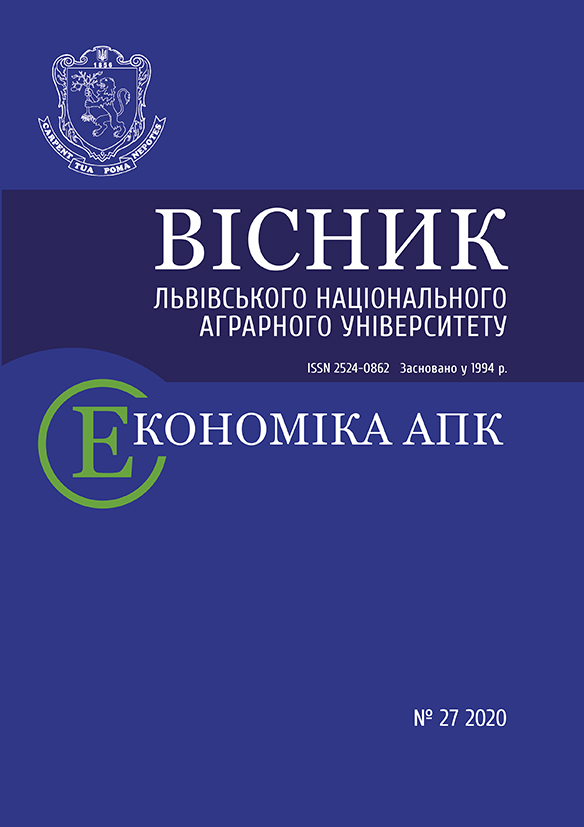Visnyk LNAU: Architecture and Farm Building 2021 №22: 17-22
THEORETICAL EVALUATION OF THE TENSILE STRENGTH OF CONCRETE REINFORCED WITH STEEL FIBER WITH CURVED ENDS
R. Kinash, Doctor of Technical Sciences
ORCID ID: 0000-0001-6715-9583
V. Bilozir, Candidate of Technical Sciences
ORCID ID: 0000-0002-8231-1325
І. Bidenko, PhD student
ORCID ID: 0000-0002-2418-353X
Lviv National Agrarian University
https://doi.org/10.31734/architecture2021.22.017
Annotation
The article presents the results of theoretical evaluation of tensile strength of concrete reinforced with steel fiber with bent ends. When calculating the load-bearing capacity of the elements of reinforced concrete structures, first determine the value of the tensile strength of reinforced concrete. There are two cases of fiber at the stage of extreme equilibrium. In the first case, it is assumed that part of the fibers is torn, and part is pulled out. In the second case, all the fiber is pulled out. In order to determine how the fiber will work when breaking a stretched specimen, it is necessary to determine the length of the fiber anchoring l_fb, at which half the length of the fiber l_f laid in the concrete is sufficient to ensure its rupture. Since l_fb depends on the coefficient η_f, which takes into account the anchoring of the fiber, its experimental determination and reasonable purpose in the design standards is crucial to ensure the accuracy of determining the tensile strength of reinforced concrete. When performing studies on the extraction of anchor fiber from concrete prisms 100 x 50 x 50 mm made of fine-grained concrete of different classes, the authors determined the value of η_f and found that for the same lengths of fiber laying, this coefficient increases with increasing concrete strength. Within a particular class of concrete, it increases with increasing length of fiber laying. The reason that this coefficient is not constant, in our opinion, is that this fiber contains anchors, which at short lengths of laying fiber in concrete provide a significant increase of fiber stresses during its extraction. This effect of the anchor on the stress of the fiber during extraction from concrete decreases with increasing length of its laying. According to the results of tests of fiber for pulling from fine-grained concrete, a refined formula for determining the tensile strength of reinforced concrete is proposed, which takes into account both the adhesion of fiber to concrete on its smooth part and the effect of end anchors. Further experimental studies of the tensile strength of reinforced concrete will, if necessary, make additional clarifications to the proposed calculation apparatus.Key words
orthotropic deck, calculation model, Winkler elastic foundation, basic functions of different orders, shape functions, load functions
Link
- Bilozir V. V. Formation and opening of cracks in normal sections of bent steel-fiber concrete elements on fiber from sheet: dis ... cand. tech. science. Moscow, 1991. 164 p. [in Russian].
- Bilosir W., Krapfenbauer R., Bölcskey E. Strength and stability of steel fiber concrete elements with sheets made of sheet metal. Austrian magazine for engineers and architects, 1995. Volume 140. No 2. P. 38–53. [in Germany].
- Bilozir V., Vysochenko A. Determination of the required length of fiber anchoring in concrete. Bulletin of Lviv National Agrarian University. Ser. Architecture and agricultural construction, 2013. No. 14. P. 64–70. [in Ukrainian].
- Bilozir V. V Deformation method of calculation of bending reinforced concrete elements. Bulletin of the National University «Lviv Polytechnic». Ser. Theory and practice of construction. 2012. No 742. P. 18–24. [in Ukrainian].
- DSTU-N B B.2.6-218: 2016 Guidelines for the design and manufacture of structures of dispersed reinforced concrete. Kyiv: SE “UkrNDNC”, 2017. 32 p. [Effective from 04.01.2017]. [in Ukrainian].
- Kinash R., Bilozir V. Deformational calculation method of bearing capability of fiber-concrete steel bending elements. Czasopismo Techniczne (Technical Transactions: Architecture), 2014. I. 8-A (15). No 111. P. 49–58.
- Kinash R., Bilozir V., Shmyh R., Vysochenko A. Suspensibility of Steel Fibre Reinforce d Concrete Values with External Ribbed Armature. IOP Conference Series: Materials Science and Engineering, 2019. Vol. 471 (5).
- Kinash R., Bilozir V., Shmyh R., Bidenko I. Deformability of Steel-Fiber Beams with External Tape Reinforcement. IOP Conference Series: Materials Science and Engineering, 2020. Vol. 960 (2).
- Rabinovich F. N. Dispersed reinforced concrete. Moscow: Stroyizdat, 1989. 174 p. [in Russian].
- Recommendations for the design and manufacture of steel-fiber-reinforced concrete structures. Moscow: RDTICRC Gosstroya USSR, 1987. 148 p. [in Russian].
- SP 360.132580.2017 Steel fiber-reinforced concrete structures. Design rules. Moscow: Standardinform, 2018. 70 p. [Introduction. in action. 2018.06.12]. [in Russian].



